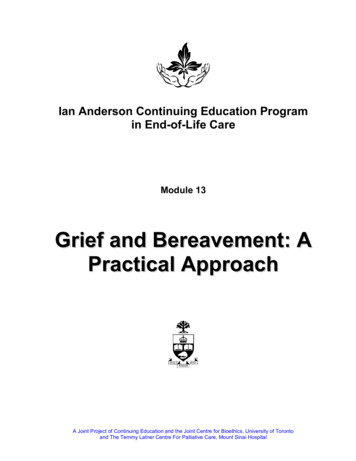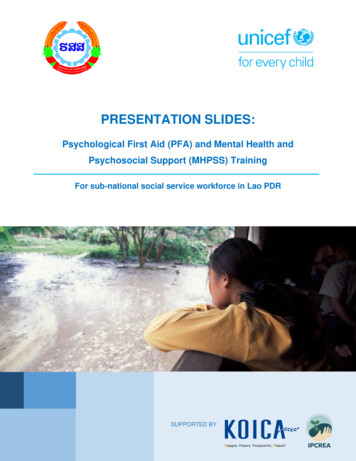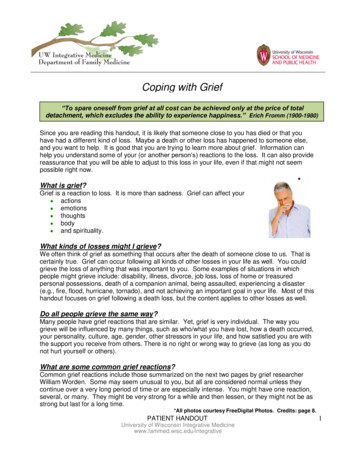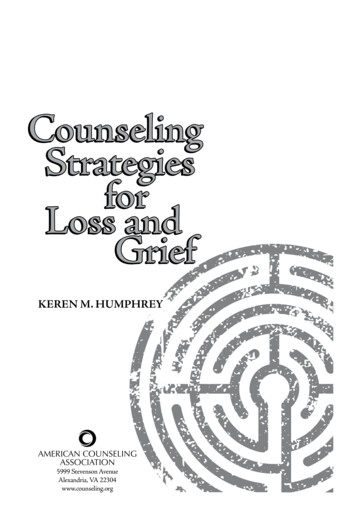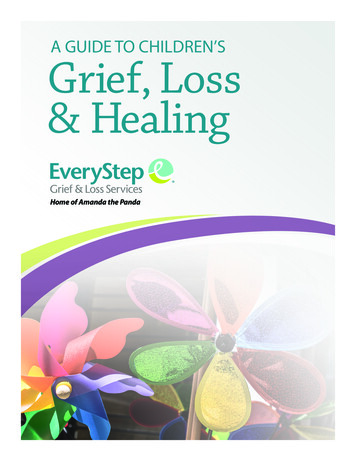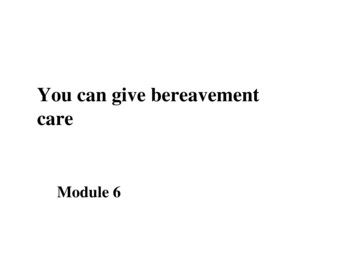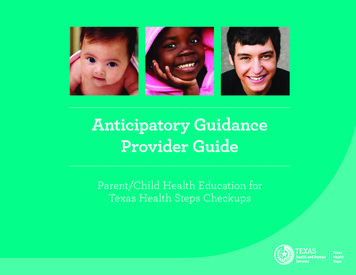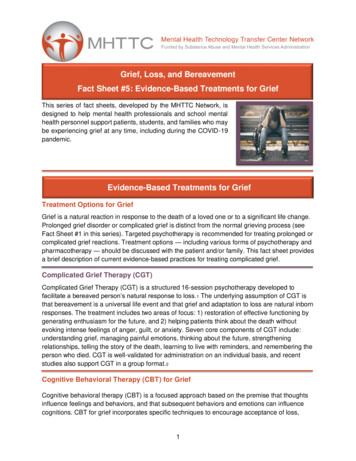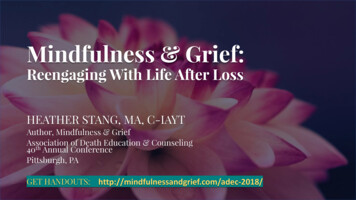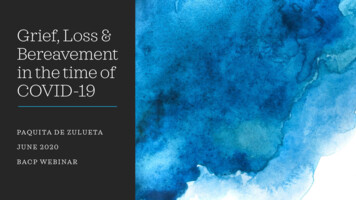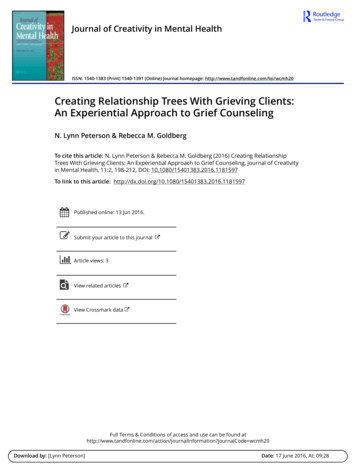
Transcription
RehabKidsAnticipatory Grief:Help Clients Face Impending Lossand Uncertain FuturesErica H. Sirrine, Ph.D., LCSW, FTWELCOME!Connecting Knowledge With Need is our mission. Thank you for joining us today!We’d love to hear where you are and what you’re learning. Share your photos by tagging usand using #PESISeminar and/or #LearningWithPESI. You’ll receive a special offer each time!And be sure to follow us for FREE tips, tools, and www.pinterest.com/pesiincwww.pesi.com/blog www.pesirehab.com/blog www.pesihealthcare.com/blog https://kids.pesi.com/blog
Anticipatory Grief:Help Clients Face Impending Lossand Uncertain FuturesErica H. Sirrine, Ph.D., LCSW, FTRehabKidsZNM0579904/21
Copyright 2021PESI, Inc.PO Box 10003839 White Ave.Eau Claire, Wisconsin 54702Printed in the United StatesPESI, Inc. strives to obtain knowledgeable authors and faculty for its publications andseminars. The clinical recommendations contained herein are the result of extensiveauthor research and review. Obviously, any recommendations for client care must beheld up against individual circumstances at hand. To the best of our knowledge anyrecommendations included by the author reflect currently accepted practice. However,these recommendations cannot be considered universal and complete. The authorsand publisher repudiate any responsibility for unfavorable effects that result frominformation, recommendations, undetected omissions or errors. Professionals usingthis publication should research other original sources of authority as well.All members of the PESI, Inc. CME Planning Committee have provided disclosure offinancial relationships with commercial interests prior to planning content of thisactivity. None of the committee members had relationships to reportPESI, Inc. offers continuing education programs and products under thebrand names PESI HealthCare, PESI Rehab, PESI Kids, PESI Publishing andPsychotherapy Networker. For questions or to place an order, please visit: www.pesi.com or call our customer service department at: (800) 844-8260.14pp4/21RehabKids
Materials Provided ByErica H. Sirrine, Ph.D., LCSW, FT, is a licensed clinical socialworker, qualified clinical supervisor and the dean of the Schoolof Social Work at Southeastern University. She has over 17 yearsof experience in the field of death, dying and bereavement andhas been awarded the distinction of Fellow in Thanatology bythe Association for Death Education and Counseling. She hasconducted and published research on the continuing bondsmaintained by survivors following a death, and she recentlyauthored and published Sammy’s Story, an anticipatory griefcounseling book for young children experiencing the seriousillness of a loved one.Dr. Sirrine has extensive expertise providing individual andgroup therapy to bereaved children, adolescents, adults andfamilies. She has implemented numerous interventions andprograms aimed at improving the emotional health of clientsexperiencing loss. Dr. Sirrine presents seminars on bereavementand loss throughout the United States and is known for herinteractive and engaging workshops. She has been distinguishedas “Professor of the Year” and the National Association of SocialWorkers Heartland, Florida Unit’s “Social Worker of the Year.”Speaker Disclosure:Financial: Erica Sirrine receives compensation as an Associate Professor at SoutheasternUniversity. She receives a speaking honorarium from PESI, Inc.Non-financial: Erica Sirrine is a member of the National Association of Social Workers, TheAssociation of Baccalaureate Program Directors, the National Alliance for Grieving Children, andthe Florida Association of Deans and Directors. She does not receive compensation.Materials that are included in this course may include interventions and modalities that are beyond theauthorized practice of mental health professionals. As a licensed professional, you are responsible forreviewing the scope of practice, including activities that are defined in law as beyond the boundaries ofpractice in accordance with and in compliance with your professions standards.
Grief Summit 2021:Anticipatory Grief- Helping Clients Copein the Face of Impending Loss andUncertain FuturesDr. Erica Sirrine, Ph.D., LCSW, FTwww.hopeandgrief.com1APA DisclosureMaterials that are included in this course may include interventions and modalities that are beyond theauthorized practice of mental health professionals. As a licensed professional, you are responsible for reviewingthe scope of practice, including activities that are defined in law as beyond the boundaries of practice inaccordance with and in compliance with your professions standards.21
Anticipatory Grief3“Stages of Death and Dying”(DABDA)42
Sustained Hope inAnticipatory Grief5Anticipatory Grief Emotions63
Common Anticipatory Grief Reactions Regressive Behaviors Guilt/Regret Magical Thinking Fear/Anxiety Disbelief/Confusion Helplessness Difficulty Concentrating/Forgetfulness Faith/Spirituality Questions Change in school work/grades Isolation/Loneliness Sadness/Depression “Grief Bursts” Mood Changes Physical Symptoms (stomach/headaches,etc.) Anger/Protest Sleep Problems/Disturbances Acting out/Aggressive behavior Lethargy/Fatigue7The Pandemic’s Impact on Grief Increased Isolation Fewer Opportunities for Face-to-Face Support Support System is Now Coping with their Own Losses Disguised/Masked Grief Loss of Funeral/Memorialization Rituals Loss of Control84
Continuing Bonds Sigmund Freud’s Grief Work Theory John Bowlby’s Attachment Theory Physical vs. Emotional Attachment9Anticipatory Grief InterventionsBefore the Death Anticipatory Grief Counseling- Case Example: “Heather” Provide Death Education and Practical Support Linking Objects Legacy Journals/Letters/Video Video Diaries/Life Review Anticipatory Grief Retreats and Hope@Home Groups Inheritance of Hope105
Anticipatory Grief InterventionsAfter the Death Attend Funeral/Memorial Service Condolence Calls/Letters/Flowers Prepare Children and Adults to Return to School/Work Prepare Children to Attend Funeral/Memorial Service11Talking to Kids about Terminal Illness Do:Do’s and Dont’s Be honest, clear, and direct Normalize feelings of anticipatory grief Model healthy mourning behaviors and coping skills Use concrete terms when discussing illness and death Foster an environment encouraging open and honest dialogue about the impending death Provide a caring and supportive environment Provide opportunities for memorialization/funeral rituals Don’t: Lie or conceal the reality Avoid the subject Use platitudes or euphemisms126
Explaining the Dying Process to Children Identify a trustworthy adult to be present Be honest and encourage questions Prepare children in advance about medical equipment/devices/personnel in the room Discuss the body’s process of dying Allow continued communication with person who is ill (per developmental age) Emphasize that hearing remains until the end13Preparing Kids for Funerals and Memorials Educate about Funeral Ritual (Who, What, When, Where, Why) Discuss Expected Emotions/Grief Reactions of Adults Explain Body Disposition/Viewing Expectations Prepare Activities for Younger Children- Case Example: “Poster Boards, Pictures, andMemories” Allow Children/Teens to Participate in Planning Identify a Supportive Adult Never Force a Child to Attend147
Preparing for Return to School Notify Caregivers of Death Teachers, guidance counselors, principal, extracurricular activity directors, and coaches Educate Caregivers about Death Expected and normal grief reactions Classroom/schoolwork/homework needs Identification of “safe” support person and place Prepare fellow students15Preparing for Return to School/Work Provide Psycho-education for Successful Reintegration Management of grief waves and reactions Emotional time-outs Cognitive/concentration difficulties Preparation for questioning by others Possible feelings of isolation (feeling ignored)168
Identifying Sources of Support17Activity:Circle of Support189
19202010
Love after Loss: An Illustration21222211
Hope and HealingAmid Anticipatory Grief“Truly it is in darkness that one finds the light, so when we arein sorrow, then this light is nearest of all to us.”-Meister Eckhart23Questions?erica@hopeandgrief.com2412
Grief Summit 2021- ReferencesErica SirrineAnticipatory GriefReferencesCoehlo, A., de Brito, M., Teixeira, P. Frade, P., Barros. L., & Barbosa, A. (2020). Familycaregivers' anticipatory grief: A conceptual framework for understanding its multiplechallenges. Qualitative Health Research 30 (5), ehlo, A., & Barbosa, A. (2017). Family anticipatory grief: An integrative literature review.American Journal of Hospice and Palliative Medicine, 34 (8), 774-785. doi:10.1177/1049909116647960Ener, L., & Ray, D.C. (2018). Exploring characteristics of children presenting to counseling forgrief and loss. Journal of Child and Family Studies, 27 (3), 860-871. doi: 10.1007/s10826017-0939-6Kübler Ross, E. (1971). What is it like to be dying? American Journal of Nursing, 71 (1), 53-60.Meager, D.K., & Balk, D.E. (2013). Handbook of Thanatology (2nd ed). New York:Routledge.Moon, P.J. (2016). Anticipatory grief: A mere concept? The American Journal of Hospice &Palliative Care, 33 (5), 417-20. doi: : 10.1177/104990911557426Patinadan, P.V., Tan-Ho, G., Choo, P.Y., & Yan Ho, A.H. (2020): Resolving anticipatory griefand enhancing dignity at the end-of life: A systematic review of palliative interventions.Death Studies, 1-14. doi: 10.1080/07481187.2020.1728426Rubin, S. S. (1999). The two-track model of bereavement: Overview, retrospect, andprospect. Death Studies, 23(8), 681-714. doi:10.1080/074811899200731Rubin, S.S., & Shechory-Stahl, M. (2013). The continuing bonds of bereaved parents: A ten-yearfollow-up study with the two-track model of bereavement. OMEGA, 66(4), 365-384. doi:http://dx.doi.org/10.2190/OM.66.4.fShaver, P. R., & Tancredy, C. M. (2001). Emotion, attachment, and bereavement: A conceptualcommentary. In H. Schut (Ed.), Handbook of bereavement research: Consequences, coping,13
and care. (pp. 63-88). American Psychological Association. doi:10.1037/10436-003Sirrine, E. H. (2017). Sammy's Story. Publisher: Author.Sirrine, E. H., Salloum, A., & Boothroyd, R. (2017). Predictors of continuing bonds amongbereaved adolescents. OMEGA: Journal of Death and Dying, 76 (3), 237-255.doi.org/10.1177/0030222817727632Stroebe, M., Schut, H., & Boerner, K. (2017). Cautioning healthcare professionals: Bereavedpersons are misguided through the stages of grief. OMEGA: Journal of Death and Dying, 74(4), 455-473. doi: 10.1177/003022281769187014
NOTES
NOTES
authored and published Sammy’s Story, an anticipatory grief counseling book for young children experiencing the serious illness of a loved one. Dr. Sirrine has extensive expertise providing individual and group therapy to bereaved children, adolescents, adults and families. She ha
